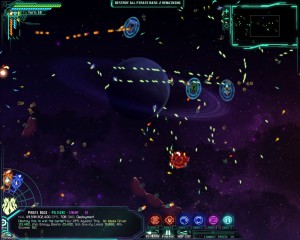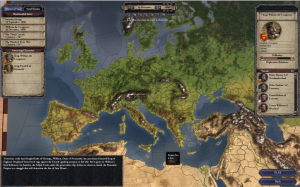Today’s post is a continuation on my thoughts of teaching players how a game works. In my previous post, I talked about a hierarchy of learning based around three questions. For this post, I want to talk specifically about the structure of tutorials in game design and what needs to be in them.
We’re going to be focusing more on abstracted or strategy game design rather than action-based games, the reason is that action games are a lot easier to teach a player. The following elements that we’re going to talk about in order should be a defacto inclusion in your game/tutorial.
1. An actual tutorial
In my previous post, I talked about the trouble with designing a tutorial scenario that’s separate from the main game, but that doesn’t mean you can ignore not having a tutorial. The more complicated your game is to learn, the more structure you need to at least get someone off the ground in terms of learning how things work.
For action games, many titles simply use the first area or section of the game as the tutorial; case in point: the Souls series. While technically the game doesn’t stop or take the player out of the game for the tutorial, it’s an integrated system and part of the title’s design.
Too often in strategy games, I see game designers go with a tutorial guideline system: Where the game leaves everything open and simply shows popups about what’s going on. I cannot stress enough how bad this is at teaching someone how to play your game.
The problem is that it’s very easy for the player to misclick and suddenly the screen is filled with all kinds of information that they have no idea what they’re looking at. These kinds of tutorials also assume prior knowledge on the player’s part which we’ll talk more about in the next section.
The point of the tutorial is to provide guidance to the player, meaning that it has to walk them through how the game works.
2. From the Top
This point should go without saying, but it’s another area where a lot of game designers screw up on: Never assume that the player read your manual or played past games in the series when designing a tutorial. There’s nothing more that causes “deer in a headlights,” syndrome more, when I load up a game for the first time and the first tutorial message tells me something that I have no idea what they’re talking about, because the game is assuming knowledge that I don’t have.
The point of the tutorial is to teach someone who has never played your game before how it works; that means someone who probably didn’t read the manual or knew that there was one available. These are the following things that every tutorial should start with in any video game: What are the controls, what am I looking at, what’s step one to your game?
Going back to my hierarchy of learning, you need to ease a new player into learning how your game works; if something isn’t vital to playing the game, don’t show it to the player or mention it at the start.
Also, one special point for strategy games, tutorials need to start at square one with your design, that means if the player has to make a number of decisions in terms of starting conditions, then the tutorial needs to begin there.
To put this all another way, if your tutorial requires the player to read the manual (AKA, a tutorial for the tutorial,) then you have failed in your tutorial design.
3. Step by Step
This next point is basically the previous post’s points. The player needs to learn the what, the how and the why/when in order to be able to play your game. That means designing the tutorial in the order that someone would be playing the game. Offworld Trading Company had an excellent tutorial in this regard: Breaking it into multiple parts designed to walk a player through the order of playing a game.
As a matter of fact, the developers did a good job with the previous point as well: Limiting the player’s access to systems and details as they learned the basics of the game; making sure that someone learned the game’s rules in the order of priority to actually playing the game. The tutorial structure went through the exact order of systems and mechanics while slowly unlocking more options until the very end.
Despite the simplicity of the tutorial, Dark Souls 3 is a recent example of how to break down the mechanics.
It starts with simply telling the player how to move around, then how to swing a weapon, then how to use an item, then backstabbing and other advanced moves, before wrapping up with a final section of fighting enemies and a boss. Speaking of that boss fight, that’s a good segue way into an understated element that tutorials should have.
4. The Test
If you’re going to use a tutorial to measure whether the player is ready to play your game, then there needs to be some actual form of measurement. Once the player is done with learning the rules and mechanics, it’s important to actually give the player a chance to use those mechanics and systems within the context of the game.
Giving the player five pages of text that tells them how the economy works isn’t the same as actually doing it. Without the testing portion of the tutorial, there’s no way for the player to actually apply the lessons they hopefully learned in the previous section. Testing can be either after each lesson of the tutorial or at the very end, but it needs to occur at some point during it.
The Souls series is another great point in this regard. Both #1 and #3 have their tutorial sections end with a boss fight. While this boss is the easiest of all the bosses in the game, it’s the final test to prove that the player actually knows how the game works. If you can’t get pass Ludex Gundyr in Dark Souls 3, there’s no way you’re going to get far in the game.
Not every test needs to be about fighting a massive boss; you could simply have a gap that the player has to jump across if you want to teach them jumping mechanics.
The point is simply that for every lesson you want to teach the player, the player needs to do something to show that they followed the lesson beyond just clicking “next” on dialogue boxes.
Creating a Lesson Plan:
Again, I cannot stress this enough for game designers reading this, but watch how someone plays your game and use that as the basis for the tutorial. While you can’t expect a player to sit through hours of Let’s Plays to figure out your game, that doesn’t mean you can’t use them when coming up with how to properly teach someone the game.
You would think that the tutorial would be the easiest part of a game’s design to create as a developer, but it seems like more and more developers these days are screwing up on this part; losing untold numbers of potentially new fans to not just the game, but the genre itself. Just watching someone attempt to play through your game and fumble through the mechanics and UI can be enough to base a tutorial structure off of; hell, you could watch me try to play a Paradox Software 4X game and take notes from that.
If you enjoyed this post, please consider donating to the Game-Wisdom Patreon Campaign. Your donations will help to keep Game-Wisdom going and allow me to continue to put out great content.






